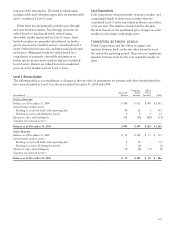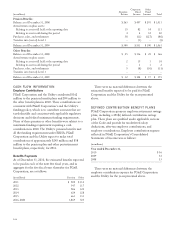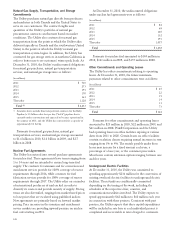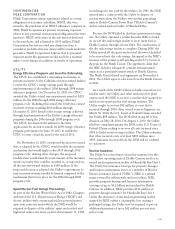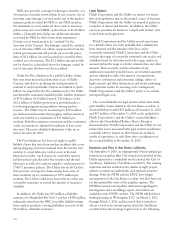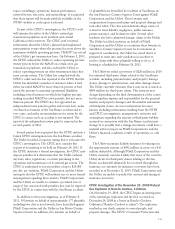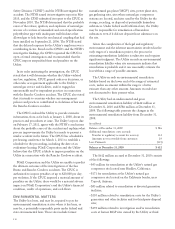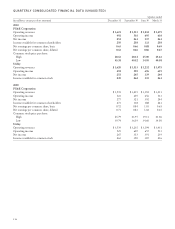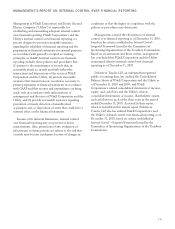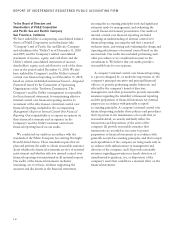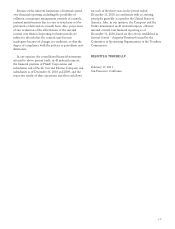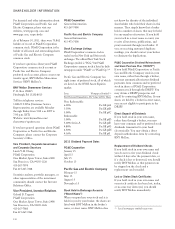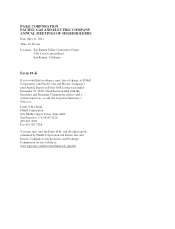PG&E 2010 Annual Report Download - page 116
Download and view the complete annual report
Please find page 116 of the 2010 PG&E annual report below. You can navigate through the pages in the report by either clicking on the pages listed below, or by using the keyword search tool below to find specific information within the annual report.
Safety Division (“CPSD”) and the NTSB investigated the
accident. The NTSB issued its investigative report in May
2010, and the CPSD submitted its report to the CPUC in
November 2010. The NTSB determined that the probable
cause of the release, ignition, and explosion of natural gas
was use of a section of unmarked and out-of-specification
polyethylene pipe with inadequate wall thickness that
allowed gas to leak from the mechanical coupling that had
been installed on September 21, 2006. The NTSB stated
that the delayed response by the Utility’s employees was a
contributing factor. Based on the CPSD’s and the NTSB’s
investigative findings, the CPSD requested the CPUC to
open a formal investigation and recommended that the
CPUC impose unspecified fines and penalties on the
Utility.
In its order instituting the investigation, the CPUC
stated that it will determine whether the Utility violated
any law, regulation, CPUC general orders or decisions, or
other rules or requirement applicable to the Utility’s
natural gas service and facilities, and/or engaged in
unreasonable and/or imprudent practices in connection
with the Rancho Cordova accident. The CPUC also stated
that it intends to ascertain whether any management
policies and practices contributed to violations of law and
the Rancho Cordova accident.
The CPUC ordered the Utility to provide extensive
information, from as far back as January 1, 2000, about its
practices and procedures at issue. The Utility’s report, due
on February 17, 2011, agrees with the NTSB’s conclusions
about the probable cause of the accident and explains what
process improvements the Utility has made to prevent a
similar accident in the future. The CPUC has scheduled a
pre-hearing conference for March 1, 2011 to establish a
schedule for the proceeding, including the date of an
evidentiary hearing. PG&E Corporation and the Utility
believe that the CPUC is likely to impose penalties on the
Utility in connection with the Rancho Cordova accident.
PG&E Corporation and the Utility are unable to predict
the ultimate outcome of the investigations of the San
Bruno and Rancho Cordova accidents. The CPUC is
authorized to impose penalties of up to $20,000 per day,
per violation. If the CPUC imposed a material amount of
penalties on the Utility, there would be a material adverse
impact on PG&E Corporation’s and the Utility’s financial
condition, results of operations, and cash flows.
ENVIRONMENTAL MATTERS
The Utility has been, and may be, required to pay for
environmental remediation at sites where it has been, or
may be, a potentially responsible party under federal and
state environmental laws. These sites include former
manufactured gas plant (“MGP”) sites, power plant sites,
gas gathering sites, sites where natural gas compressor
stations are located, and sites used by the Utility for the
storage, recycling, or disposal of potentially hazardous
substances. Under federal and California laws, the Utility
may be responsible for remediation of hazardous
substances even if it did not deposit those substances on
the site.
Given the complexities of the legal and regulatory
environment and the inherent uncertainties involved in the
early stages of a remediation project, the process for
estimating remediation liabilities is subjective and requires
significant judgment. The Utility records an environmental
remediation liability when site assessments indicate that
remediation is probable and it can reasonably estimate the
loss within a range of possible amounts.
The Utility records an environmental remediation
liability based on the lower end of the range of estimated
costs, unless an amount within the range is a better
estimate than any other amount. Amounts recorded are
not discounted to their present value.
The Utility had an undiscounted and gross
environmental remediation liability of $612 million at
December 31, 2010 and $586 million at December 31,
2009. The following table presents the changes in the
environmental remediation liability from December 31,
2009:
(in millions)
Balance at December 31, 2009 $ 586
Additional remediation costs accrued:
Transfer to regulatory account for recovery 112
Amounts not recoverable from customers 29
Less: Payments (115)
Balance at December 31, 2010 $ 612
The $612 million accrued at December 31, 2010 consists
of the following:
• $45 million for remediation at the Utility’s natural gas
compressor site located near Hinkley, California;
• $171 for remediation at the Utility’s natural gas
compressor site located on the California border, near
Topock, Arizona;
• $85 million related to remediation at divested generation
facilities;
• $110 million related to remediation costs for the Utility’s
generation and other facilities and for third-party disposal
sites;
• $139 million related to investigation and/or remediation
costs at former MGP sites owned by the Utility or third
112



